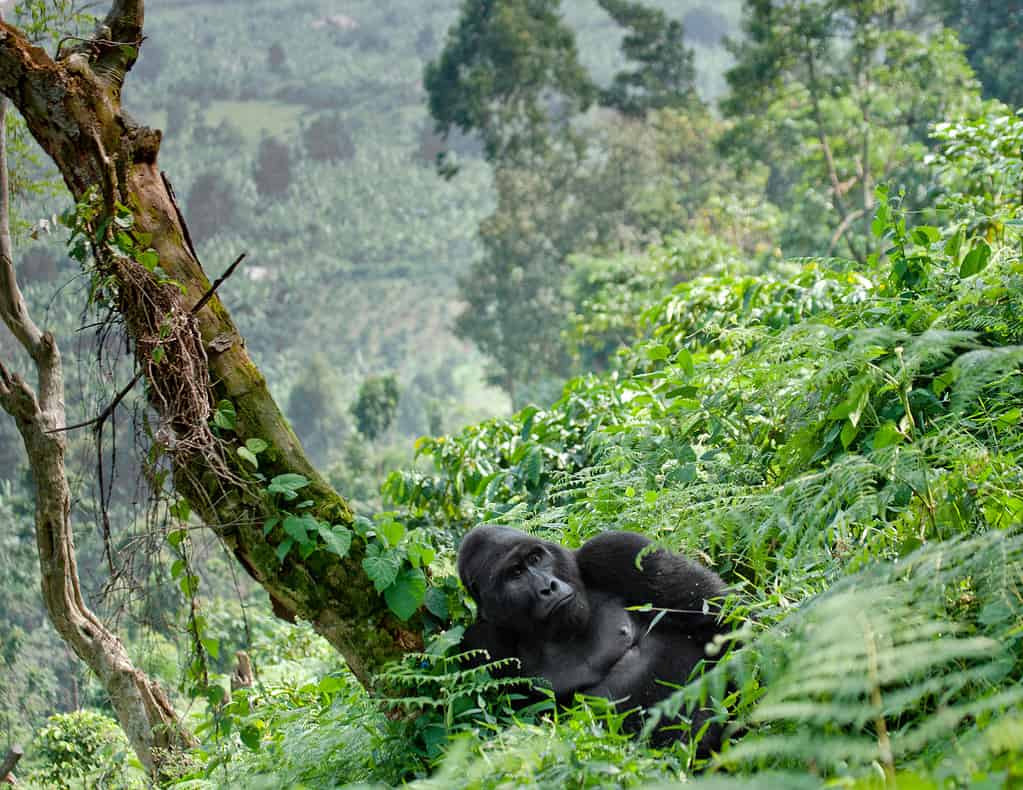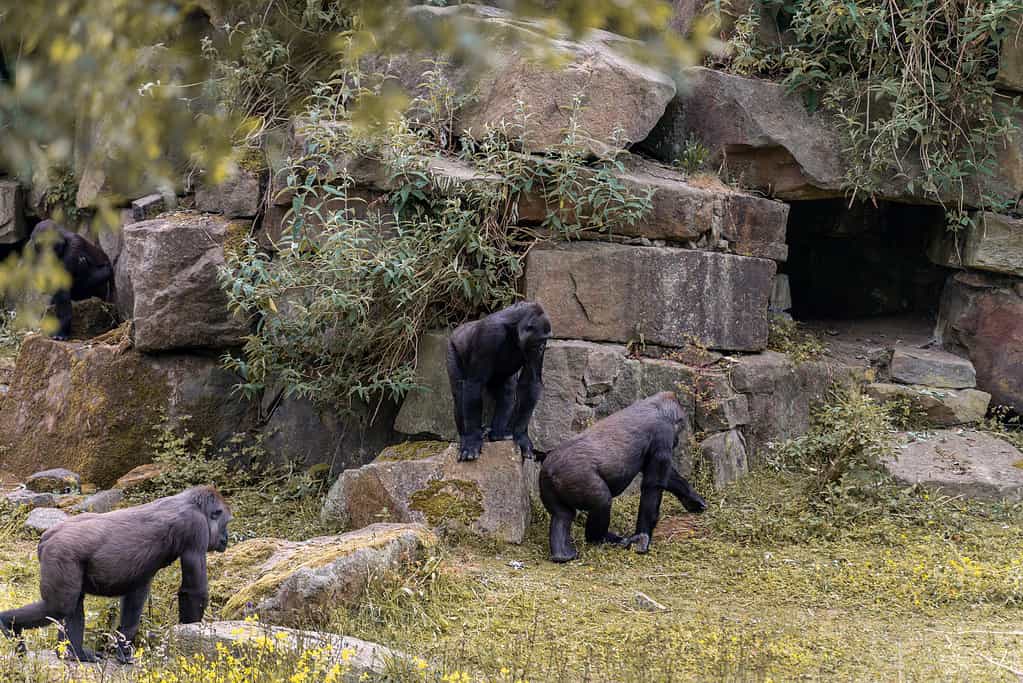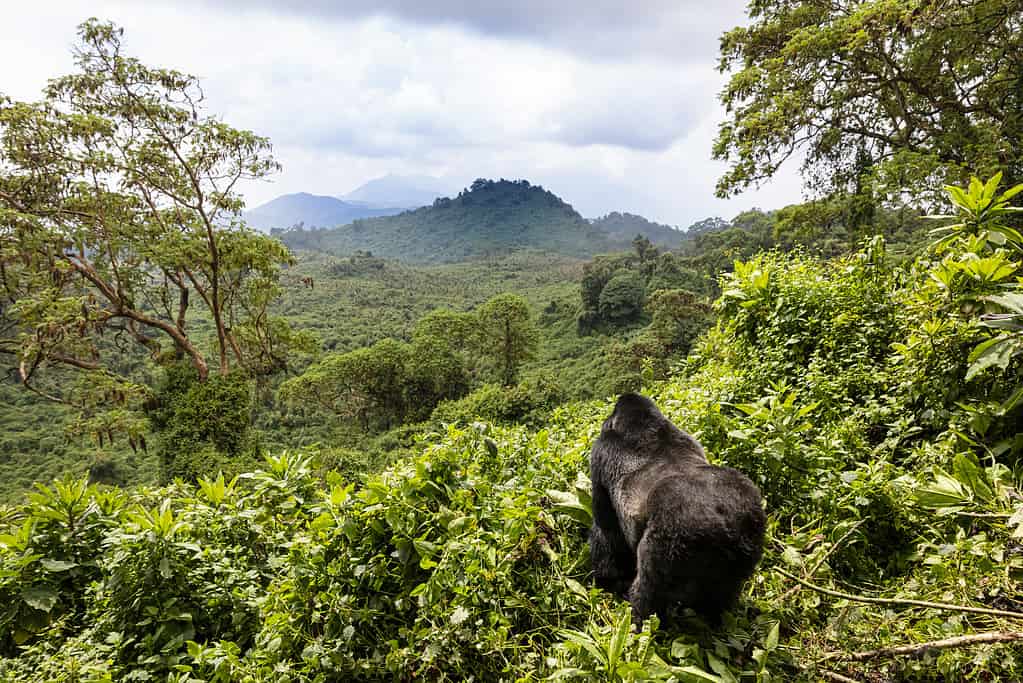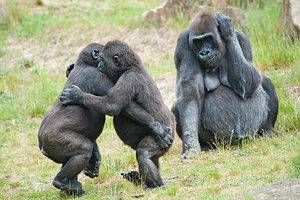
Several nature reserves in African shelter large primates from hunters while supporting their repopulation.
©ANDREYGUDKOV/iStock via Getty Images
Gorillas are one of nature’s most fascinating creatures. They are powerful, majestic, and mysterious animals who are still relatively new to human comprehension. These animals hide in the shadows for so long that many originally believed them to be a myth.
Considering how large the human population is, why did it take so long for gorillas to be discovered? Where were they hiding? What did the Indigenous people of Africa believe them to be?
Let’s dig into the history of gorillas and what makes them so enigmatic.
Early Depictions of Gorillas

Early depictions of gorillas describe them as monsters or a tribe of hairy humans.
©Damien Platt/iStock via Getty Images
Despite hundreds of years of exploration and discovery, gorillas were mysterious animals until the 1800s. Some of the earliest depictions and stories about gorillas are folktales of creatures or monsters that looked like humans.
Explorers throughout Africa drew concept illustrations and gave them to others to elicit intrigue in the area. Large-scale portraits were given to royalty and emperors as presents highlighting unique, never-before-seen animals.
Scientists theorized that gorillas were a sub-species of humans or the connective “missing link” between modern human evolution and primates.
When Were Gorillas Discovered
American naturalist Thomas S. Savage conducted an expedition into Africa, stumbling upon the first evidence of gorilla existence. In 1847, he found a skull that did not match any other skulls on record. He declared the skull a new species, garnering interest in conducting further expeditions to the area.
Between 1855 and 1859, French explorer Paul Du Chaillu took Thomas Savage’s research and conducted an expedition to Gabon, Central Africa. His journey confirmed the existence of gorillas with visual sightings and photographic evidence.
Mountain Gorilla Discovery

Mountain gorillas enjoy living at high altitudes and sleeping in thick trees to avoid predators.
©Ross Ford/iStock via Getty Images
Later, in 1902, German explorer and hunter Robert von Beringe made it a mission to track, hunt, and bring back a gorilla as evidence. Von Beringe and his team trekked through the deep jungles, killing two gorillas to bring back as proof. His notes remarked how large the animals were and how some were shot but continued fleeing, citing their impressive strength.
For his success, the mountain gorilla was given the scientific name Gorilla gorilla beringei.
Cross River Gorilla Discovery

Gorillas are very calm and shy animals, preferring to be left alone with their troop.
©Lisa Frias/iStock via Getty Images
The excitement of discovering gorillas quickly grew, encouraging the scientific community to race to learn all they could about the new species.
In 1904, two years after Robert von Beringe discovered the mountain gorillas, Paul Matschie discovered evidence of the Cross River gorillas. Paul Matschie was a German zoologist known for finding several new species of reptiles and mammals.
On an expedition, he found the bones of a Cross River gorilla, but could not find the animals firsthand. In fact, scientists believed Cross River gorillas were hunted to extinction until their rediscovery in the 1980s.
After the Universal monster movie King Kong, gorillas become a household name. They became symbols of potential new prey which attracted sport hunting.
Why Are Gorillas Hard to Find?

The vast jungles in Africa provide the perfect cover for any animal to remain undetected.
©Dennis Stogsdill/iStock via Getty Images
The scientific community is still conducting expeditions to Africa to study these amazing animals firsthand. The problem is they can be extremely difficult to find, which is why they were so difficult to discover in the first place.
Gorillas are hard to find in the wild due to several factors:
- Dense Habitat: Gorillas live in incredibly dense forests that are difficult to traverse. The large trees, thick bushes, uneasy terrain, and abusive humidity make it difficult for people to navigate and track without years of experience.
- High Altitudes: Gorillas are versatile survivors, but they prefer to spend their nights at high altitudes. Higher elevations make it difficult to breathe for people not used to the environment.
- Camouflage: They have dark hair covering their body, making them easily blend into the many shadows produced by the tall trees. Despite being 4 to 6 feet tall, they are elusive.
- Constantly Moving: Gorillas are considerate and intelligent animals regarding their environment. They continually move locations, rarely staying in one place longer than a day. After they eat a large portion of the greenery in the area, they move to other locations, allowing plants to replenish without exhausting the soil.
- Hiking Experience: Trekkers wanting to see gorillas in the wild must travel through forests, valleys, rivers, streams, and steep inclines which requires many years of experience. Tracking a gorilla without frightening them away can take hours or days.
Summary of Gorilla Timeline
| Timeline | Historical Event |
|---|---|
| 1847 | Thomas S. Savage explores Africa and finds the first gorilla skull |
| 1855-1859 | Paul Du Chaillu travels to Gabon and confirms sightings of gorillas |
| 1902 | Captain Robert von Beringe hunts two gorillas, bringing them back as proof. Mountain gorilla named after him. |
| 1904 | Paul Matschie finds bones of Cross River gorillas |
| 1933 | King Kong movie released, beginning the sport-hunting of gorillas |
| 1983 | Dian Fossey releases first book, “Gorillas in the Mist,” becoming a hit and supporting gorilla conservation |
The photo featured at the top of this post is © GUDKOV ANDREY/Shutterstock.com
Thank you for reading! Have some feedback for us? Contact the AZ Animals editorial team.






